Back exercises are essential for building overall strength, maintaining good posture, and preventing injuries, and barbell back exercises are one of the most effective ways to achieve this. Barbells allow you to target multiple muscle groups in your back, helping you develop a strong, balanced physique. With just a barbell, some weight plates, and minimal space, these exercises can easily be performed at home, making them accessible and convenient for anyone looking to strengthen their back muscles.
When it comes to back training, barbells are one of the most effective tools at your disposal. They allow for progressive overload—the gradual increase of stress placed on your muscles—helping you build strength over time. Barbells also offer a wide range of movement options, enabling you to target different areas of your back with precision. If your just starting out and want to expand your home gym, check out our Ultimate Guide to Home Gym Equipment for a complete overview of what you need to create the perfect workout space at home.
Check out as well Best Back Exercises with Dumbbells You Can Do at Home here
Beginner
1.Bent-Over Barbell Row

Muscles Targeted
- Lats – Primary
- Traps
- Rhomboids
- Biceps
Equipment Needed:
- Barbell – Required
- Weight plates – Required
How to Perform:
- Set Up: Stand with your feet shoulder-width apart. Grip the bar with an overhand grip, hands positioned slightly wider than shoulder-width. Make sure you’re using a weight that allows for controlled, stable movement without compromising form.
- Hinge Forward: Keep your knees slightly bent and engage your core. Hinge forward at the hips, lowering your torso until it is at a 45-degree angle to the floor. Your back should be straight, and your chest slightly lifted. Avoid rounding your shoulders—this helps to prevent lower back strain.
- Row the Barbell: With your elbows tucked close to your body, pull the barbell toward your abdomen. Focus on squeezing your shoulder blades together as you lift. Your elbows should move up and back as you draw the barbell to your midsection. The movement should be smooth and controlled, not jerky.
- Lower the Barbell: Slowly lower the barbell back to the starting position, fully extending your arms. Avoid letting the weight pull your shoulders down—maintain tension in your back and core throughout the movement.
Tips for Proper Form:
- Keep your spine neutral (avoid arching or rounding your back) and maintain a strong core to protect your lower back.
- Focus on controlled, deliberate movements rather than rushing through the reps. This ensures maximum muscle engagement, especially in the lats and rhomboids.
- If you’re new to this exercise, start with a lighter weight and focus on form before increasing the load.
The bent-over barbell row is an excellent foundational exercise for building back strength, particularly targeting the lats, traps, and rhomboids. It’s ideal for beginners as it helps develop the mind-muscle connection needed for more advanced back movements later on.
2.Barbell Shrug

Muscles Targeted
- Traps – Primary
- Rhomboids – Primary
Equipment Needed:
- Barbell – Required
- Weight plates – Required
How to Perform:
- Set Up: Stand with your feet hip-width apart, holding the bar in front of you with an overhand grip (palms facing your body). Your hands should be about shoulder-width apart. Make sure the barbell is loaded with an appropriate amount of weight—heavy enough to challenge your traps but light enough to maintain control throughout the movement.
- Engage Your Core: Keep your spine neutral and your core tight to support your posture. Stand tall with your shoulders down and back.
- Perform the Shrug: With your arms straight and relaxed, slowly raise your shoulders toward your ears in a shrugging motion. Focus on lifting your shoulders as high as possible, squeezing your trapezius muscles at the top of the movement. Avoid bending your elbows or swinging the barbell—this ensures that you isolate the traps for maximum muscle engagement.
- Lower Your Shoulders: Slowly lower your shoulders back down to the starting position. Control the movement as you lower the barbell to fully stretch the traps and rhomboids at the bottom of the motion. This controlled lowering phase is crucial for building strength and avoiding injury.
Tips for Proper Form:
- Keep your arms straight throughout the entire exercise; bending them reduces the effectiveness of the shrug.
- Focus on a slow and controlled motion, particularly on the way down. This prevents momentum from taking over and ensures maximum muscle activation.
- Avoid rolling your shoulders during the shrug—this can strain your joints and reduce the focus on the traps.
The barbell shrug is a simple yet powerful exercise for targeting your traps and rhomboids. It’s a great way to build the upper portion of your back and enhance shoulder stability, making it ideal for beginners. This movement helps develop a strong, balanced posture and can be easily integrated into any back or upper body workout.
3.Barbell Deadlift

Muscles Targeted
- Lower back – Primary
- Glutes – Primary
- Hamstrings
- Traps
Equipment Needed:
- Barbell – Required
- Weight plates – Required
How to Perform:
- Set Up: Stand with your feet shoulder-width apart and your toes pointing slightly outward. The bar should be positioned over the midfoot, close to your shins. This stance gives you a solid base to generate power during the lift.
- Grip the Barbell: Bend at your hips and knees to lower your body and grab the barbell. Your hands should be placed just outside your knees. You can use an overhand grip (both palms facing you) or a mixed grip (one hand overhand, one hand underhand) for better control as you lift heavier weights.
- Engage Your Core and Keep a Straight Back: Before lifting, make sure your back is straight, not rounded. Engage your core by tightening your abdominal muscles. This is crucial for protecting your lower back throughout the movement. Your chest should be lifted and your gaze straight ahead, not down at the floor.
- Lift the Barbell: Drive through your heels and push the floor away as you extend your hips and knees simultaneously to lift the barbell. The bar should travel in a straight line up your body, staying close to your legs. Fully extend your hips at the top of the movement, standing tall with the barbell in front of your thighs. Avoid leaning back or overextending at the top—simply lock out your hips and knees.
- Lower the Barbell with Control: Begin the descent by pushing your hips back first, then bending your knees once the barbell passes them. Maintain a straight back and controlled movement as you lower the barbell to the floor. Don’t let the bar crash down; the lowering phase is just as important for muscle engagement and injury prevention.
Tips for Proper Form:
- Keep the barbell close to your body throughout the entire lift to reduce strain on your lower back.
- Engage your lats (upper back muscles) by imagining you’re trying to bend the bar, keeping your shoulder blades tight.
- Start with lighter weights to master the form before progressing to heavier loads.
- Avoid rounding your back at any point in the movement, as this can lead to injury, particularly in the lower back.
The barbell deadlift is one of the most foundational strength-building exercises. It targets several major muscle groups, including the lower back, glutes, hamstrings, and traps, making it ideal for building full-body strength. It’s a beginner-friendly movement, but learning proper technique is essential for safety and optimal results.
4.Barbell Upright Row

Muscles Targeted
- Deltoids – Primary
- Upper traps
- Rhomboids
Equipment Needed:
- Barbell – Required
- Weight plates – Required
How to Perform:
- Set Up: Stand with your feet shoulder-width apart, holding the barbell in front of your thighs with an overhand grip (palms facing your body). Your hands should be placed slightly narrower than shoulder-width. This starting position ensures that you can engage your traps and shoulders effectively during the lift.
- Engage Your Core and Stand Tall: Keep your chest up, shoulders back, and your core engaged throughout the movement. This posture will help maintain stability and prevent unwanted movement in your lower back.
- Pull the Barbell Upward: Begin the movement by pulling the barbell straight up along your body. Lead with your elbows, keeping them higher than your wrists as you lift. The bar should rise close to your torso until it reaches chest level, just below your chin. At the top of the movement, your elbows should flare out to the sides, and your upper arms should be parallel to the floor.
- Lower the Barbell with Control: Lower the barbell back down slowly, keeping it close to your body. Make sure the movement is controlled and smooth—don’t let the weight drop. Focus on maintaining tension in your traps, deltoids, and rhomboids as you lower the barbell.
Tips for Proper Form:
- Keep your elbows above your wrists during the lift—this ensures proper engagement of the traps and deltoids.
- Avoid using excessive weight that forces you to swing or jerk the barbell. Controlled motion is key for isolating the targeted muscles and preventing injury.
- Maintain an upright posture throughout the movement. Don’t lean back or hunch your shoulders as you lift.
- If you experience shoulder discomfort, try adjusting your grip slightly wider or use lighter weights until you build strength.
The barbell upright row is an excellent exercise for developing the upper traps, deltoids, and rhomboids, contributing to a stronger, more defined upper back and shoulders. It’s great for improving posture and adding size to the upper body. As a beginner or intermediate lifter, mastering this movement with proper form will set you up for success in more advanced exercises down the road.
Intermediate
Check out our guide to barbells and how they benefit your home gym here
5.Pendlay Row
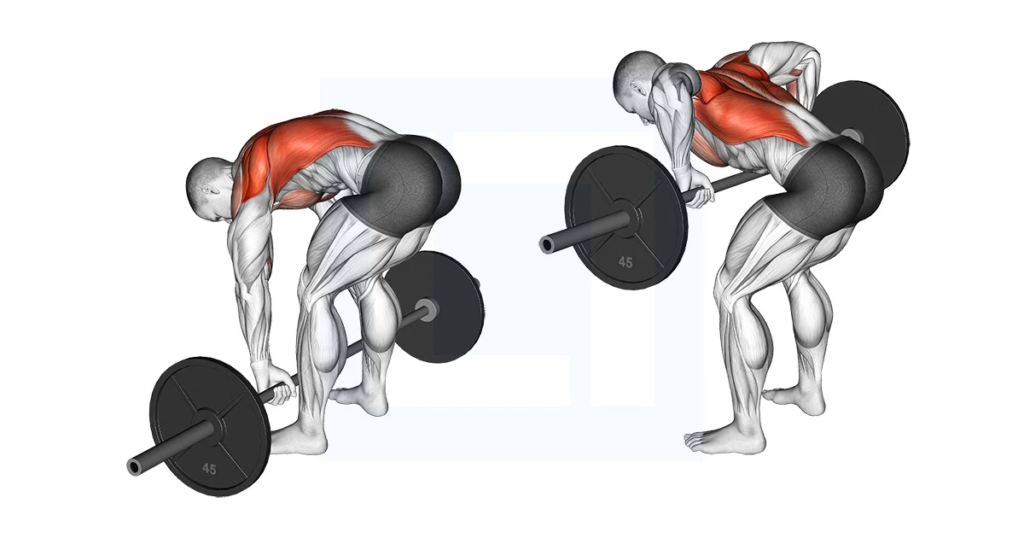
Muscles Targeted
- Lats – Primary
- Traps – Primary
- Rhomboids – Primary
- Lower back
Equipment Needed:
- Barbell – Required
- Weight plates – Required
How to Perform:
- Set Up: Begin by positioning the barbell on the floor in front of you. Stand with your feet shoulder-width apart and hinge forward at your hips, bringing your torso parallel to the ground. Keep your back straight and engage your core. Your knees should be slightly bent to allow for stability in the bent-over position.
- Grip the Barbell: Grip the barbell with an overhand grip (palms facing down) at shoulder-width. Make sure your grip is firm and that your arms are fully extended, with the bar resting on the floor between reps. This starting position emphasizes pulling power from the back muscles without momentum.
- Pull the Barbell Explosively: With your torso remaining still and parallel to the ground, explosively pull the barbell toward your chest. Focus on driving your elbows upward and back, keeping them close to your body as you row. Squeeze your shoulder blades together at the top of the movement to fully engage your lats and upper back muscles.
- Lower the Barbell and Reset: Lower the barbell back to the floor in a controlled manner. Unlike other rowing exercises, the Pendlay Row requires you to reset between each rep, allowing the barbell to rest on the ground before initiating the next pull. This eliminates momentum and ensures that each repetition is performed with maximum power and precision.
Tips for Proper Form:
- Keep your back flat and parallel to the ground throughout the movement. Avoid rounding your back, as this can place unnecessary strain on your lower back and reduce the effectiveness of the exercise.
- Use an explosive movement when pulling the barbell, but maintain control as you lower it. The emphasis should be on a powerful pull, followed by a controlled reset.
- Make sure you fully reset the barbell on the floor between each rep. This helps prevent fatigue from altering your form and ensures that each rep is performed with proper technique.
- Start with a lighter weight until you’re comfortable with the movement and able to maintain strict form. As you progress, you can increase the weight to challenge your muscles further.
The Pendlay Row is a highly effective intermediate exercise for building back strength and power. It targets key muscles like the lats, traps, rhomboids, and lower back, promoting balanced development and improved pulling strength. The focus on explosive movement makes it ideal for lifters looking to increase their power output while maintaining proper form.
6. T-Bar Row
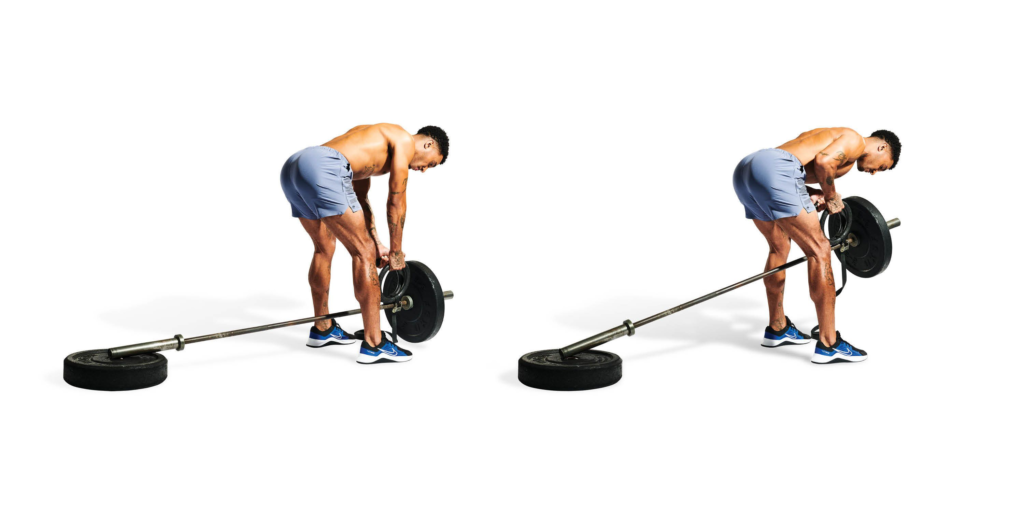
Muscles Targeted
- Lats – Primary
- Traps – Primary
- Rhomboids
Equipment Needed:
- Barbell – Required
- Weight plates – Required
- Corner or Landmine attachment – Required
- V handle
How to Perform:
- Set Up: Place one end of the barbell in a corner or a landmine attachment to secure it. The opposite end, which will hold the weight plates, should be positioned in front of you. Make sure the barbell is anchored firmly so it doesn’t shift during the exercise.
- Load the Barbell: Add weight plates to the free end of the barbell according to your strength level. If you are new to the exercise, start with lighter weights to ensure proper form before increasing the load.
- Position Yourself: Stand over the barbell, straddling it with feet about shoulder-width apart. Bend forward at the hips, keeping your back straight and your knees slightly bent. Grip the barbell close to the weighted end, using a V-handle if available, or a narrow overhand grip if not. Your torso should be angled at roughly 45 degrees to the floor.
- Pull the Barbell Up: Engage your core and, without jerking or using momentum, pull the barbell toward your chest. Focus on driving your elbows up and back as you lift, keeping them close to your body. Squeeze your shoulder blades together at the top of the movement to fully engage the lats, rhomboids, and traps.
- Lower the Barbell Slowly: Lower the barbell back to the starting position in a slow, controlled manner. Be sure to maintain tension in your back muscles throughout the descent and keep your torso still, avoiding any excessive swinging or rounding of the spine.
Tips for Proper Form:
- Keep your spine neutral and your core tight to avoid lower back strain. Your back should remain straight throughout the entire movement.
- Focus on a smooth and controlled pull. Avoid using momentum, as this shifts the focus away from your back muscles and can lead to poor form or injury.
- Maintain a slight bend in your knees to stabilize your lower body.
- If you don’t have a landmine attachment, simply wedge the end of the barbell into a sturdy corner or between heavy weights to keep it anchored.
The T-Bar Row is an excellent intermediate exercise for targeting the lats, traps, and rhomboids. It’s particularly effective for building thickness in the middle back while also improving pulling strength. This movement mimics a bent-over row but with a greater focus on maintaining stability and engaging the core, making it a valuable addition to any back workout routine.
7.Barbell Rack Pull

Muscles Targeted
- Lower back- Primary
- Traps
- Rhomboids
Equipment Needed:
- Barbell – Required
- Weight plates – Required
- Power rack – Required
How to Perform:
- Set Up: Position the barbell in a power rack at knee height or slightly below. This shortened range of motion compared to a full deadlift isolates the back muscles while minimizing strain on the legs. Load the barbell with weight plates based on your strength level. Start with moderate weight to focus on mastering your form.
- Grip the Barbell: Stand with your feet shoulder-width apart, toes slightly turned out. Approach the bar and grip it with both hands, using an overhand grip or a mixed grip (one hand overhand, one underhand) for heavier weights. Your hands should be shoulder-width apart, and your arms fully extended.
- Engage Your Core and Pull: Brace your core and keep your back straight. Begin the movement by driving through your heels and pushing your hips forward, pulling the barbell up until you are standing tall. Focus on engaging your lower back, traps, and rhomboids as you lift. Keep the barbell close to your body to protect your lower back.
- Stand Tall at the Top: Once you’re fully upright, pause briefly at the top of the movement to ensure full activation of your back muscles. Don’t lean back or overextend your spine at the top—just stand tall with a strong posture.
- Lower the Barbell with Control: Slowly lower the barbell back down to the rack by pushing your hips back and bending your knees slightly. Maintain a controlled, deliberate movement to avoid dropping the weight or using momentum. Let the bar come to a full rest on the rack before resetting for the next rep.
Tips for Proper Form:
- Keep your back straight and avoid rounding your shoulders. Engaging your core helps maintain proper posture and prevents lower back strain.
- Focus on driving through your heels and using your hips to generate the power for the lift. This helps activate the correct muscles—primarily the lower back, traps, and rhomboids.
- Don’t rush the movement. The rack pull is designed to build strength and control, so lower the barbell slowly and deliberately to maximize muscle engagement.
- Use a weight that allows you to perform the movement with perfect form. Gradually increase the weight as your strength improves.
The barbell rack pull is a powerful intermediate-level exercise that isolates and strengthens the lower back, traps, and rhomboids. By limiting the range of motion to the top half of a deadlift, it focuses on building pulling power and back strength without overstressing the legs. It’s especially useful for those looking to improve deadlift strength and back thickness while maintaining good posture and control.
Advanced
8.Barbell Snatch-Grip Deadlift
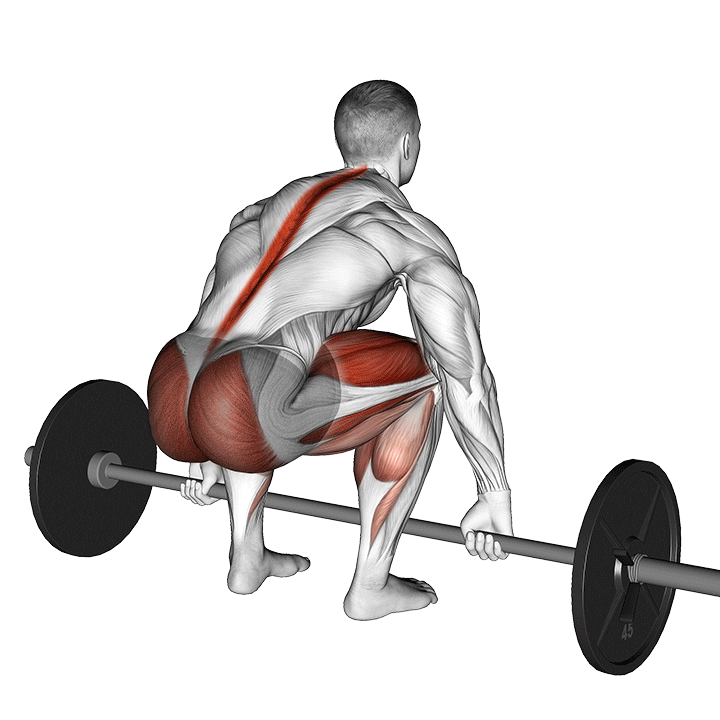
Muscles Targeted
- Lower back- Primary
- Quads – Primary
- Glutes
- Hamstrings
- Calves
Equipment Needed:
- Barbell – Required
- Weight plates – Required
How to Perform:
- Set Up: Stand with your feet shoulder-width apart and the barbell on the floor in front of you. Use a wide grip—also known as a “snatch grip”—with your hands placed far apart on the bar. Ideally, your hands should be wider than shoulder-width, close to the barbell’s outer rings. This wider grip increases the range of motion, making the exercise more challenging and effective for the back muscles.
- Grip and Position: Bend your knees slightly, hinge at your hips, and grip the barbell with your wide snatch grip. Your shoulders should be slightly in front of the bar, with your hips positioned lower than in a conventional deadlift. Engage your core and keep your back straight throughout the movement to prevent injury.
- Lift the Barbell: Begin the movement by driving through your heels and pushing your hips forward. As you lift the barbell, keep it close to your body, pulling it in a straight line. Fully extend your hips and knees at the top of the movement, standing tall. The wide grip will force your upper back and traps to work harder, while also engaging your lower back, glutes, and hamstrings. Make sure to avoid leaning back or overextending at the top.
- Lower the Barbell with Control: Reverse the movement by hinging at the hips and bending your knees, lowering the barbell in a controlled manner. Keep your back straight and maintain a strong core as you lower the barbell back to the floor. Avoid dropping the weight—slow, controlled lowering helps maintain tension in the muscles and prevents injury.
Tips for Proper Form:
- Keep the barbell close to your body throughout the lift. A straight bar path ensures that the lower back remains protected and the movement stays efficient.
- Maintain a strong grip on the barbell, especially since the wide grip can make it harder to hold onto the weight.
- Focus on a smooth, controlled ascent and descent. The snatch-grip deadlift is a technical lift, so maintaining proper form is more important than lifting heavy weights, especially for beginners to this movement.
- Engage your lats and traps by consciously pulling your shoulder blades together as you lift, ensuring the upper back muscles are fully activated.
The barbell snatch-grip deadlift is an advanced variation of the traditional deadlift, making it more challenging due to the wider grip and increased range of motion. This movement primarily targets the lats, lower back, traps, and glutes, building both strength and stability. It’s a fantastic exercise for developing pulling power and improving overall deadlift performance. However, due to its complexity, it’s essential to master the basic deadlift first before attempting this more advanced variation.
9.Barbell Good Morning

Muscles Targeted
- Lower back- Primary
- Glutes – Primary
- Hamstrings
Equipment Needed:
- Barbell – Required
- Weight plates – Required
How to Perform:
- Set Up: Stand with your feet shoulder-width apart and the barbell resting across your upper back and shoulders. Ensure that the barbell is placed securely, and if necessary, use a squat pad to protect your neck and upper back. Grip the barbell with both hands, keeping your elbows pointing down and your chest up. Engage your core to stabilize your spine.
- Hinge at the Hips: Begin the movement by hinging forward at the hips. Keep your knees slightly bent and your back straight as you lower your torso toward the floor. Your head and spine should remain in a neutral position throughout the movement—don’t round your back or bend your neck. Focus on pushing your hips back as you lean forward.
- Lower Your Torso: Continue to hinge forward until your torso is nearly parallel to the floor or as far as your flexibility allows without compromising your form. You should feel a deep stretch in your hamstrings and a strong engagement in your lower back and glutes. Avoid rushing the movement—control is key in this exercise.
- Return to Starting Position: Reverse the motion by driving your hips forward and engaging your glutes and lower back muscles. Stand tall once your torso returns to an upright position. Keep your core tight throughout the entire movement to protect your spine.
Tips for Proper Form:
- Keep your back flat and core engaged at all times. Avoid rounding your lower back, as this can lead to injury.
- Focus on the hip hinge, not the knees. Your knees should remain slightly bent, but most of the movement should come from your hips.
- Start with a lighter weight to master the form before progressing to heavier loads. This is an advanced movement that requires control and stability.
- Avoid leaning too far forward. Only go as low as your flexibility allows while maintaining a straight back.
The barbell good morning is an advanced exercise that targets the lower back, glutes, and hamstrings. It strengthens the posterior chain and helps improve hip mobility, which is crucial for performing other major lifts like deadlifts and squats. However, due to the risk of lower back strain, it’s important to perform this exercise with proper form and to start with a manageable weight until you build the necessary strength and control.
10.Barbell Romanian Deadlift

Muscles Targeted
- Lower back- Primary
- Glutes – Primary
- Hamstrings
Equipment Needed:
- Barbell – Required
- Weight plates – Required
How to Perform:
- Set Up: Begin by standing with your feet shoulder-width apart and holding the barbell at hip height. Use an overhand grip (palms facing your body), with your hands positioned just outside your thighs. Keep your core engaged and your back straight throughout the movement.
- Slight Knee Bend: Maintain a slight bend in your knees, but don’t allow them to bend any further as you lower the barbell. The Romanian Deadlift is primarily a hip hinge movement, so most of the action should come from your hips rather than your knees.
- Hinge at the Hips: Start the movement by pushing your hips back while keeping the barbell close to your legs. As you hinge forward, the barbell will slide down the front of your legs. Your back should remain flat and your chest slightly lifted to maintain proper posture and protect your spine. Keep your shoulders back and avoid rounding them forward.
- Lower the Barbell: Lower the barbell until you feel a deep stretch in your hamstrings. This will usually be when the bar reaches just below your knees or mid-shin level, depending on your flexibility. Avoid lowering the barbell too far, as this can cause your back to round or lose tension in your hamstrings.
- Return to Starting Position: Engage your hamstrings and glutes to reverse the motion. Focus on driving your hips forward to bring your torso back to the upright position. The barbell should travel back up along your legs, returning to hip height. Keep your core tight and avoid using momentum to lift the weight.
Tips for Proper Form:
- Keep the barbell as close to your body as possible during the entire movement. This helps protect your lower back and maintain proper form.
- Avoid rounding your back or shoulders—maintain a neutral spine throughout the exercise.
- Focus on hinging at the hips rather than bending at the knees. The slight bend in the knees should remain consistent throughout the lift.
- Start with a lighter weight until you’re confident in your form and can maintain control throughout the movement.
The barbell Romanian deadlift is an advanced exercise that targets the posterior chain, focusing on the lower back, glutes, and hamstrings. It’s an excellent move for building strength and flexibility in the hamstrings while also improving your hip hinge mechanics, which are essential for many other lifts. By prioritizing form and control, this exercise will help you develop greater stability and power in your lower body.
Conclusion
Incorporating barbell back exercises into your workout routine offers tremendous benefits, including increased strength, improved posture, and greater stability in everyday movements. These exercises target multiple muscle groups across the back, helping to build a balanced and powerful physique. Whether you’re a beginner working on foundational strength or an advanced lifter looking to maximize your performance, these barbell exercises can elevate your home workout routine.
It’s important to progress gradually—start with the beginner exercises and master your form before moving on to the more advanced movements. Building strength is a process that takes time, and consistency is key to seeing results. Focus on proper technique for each lift, as this not only prevents injury but also ensures that you’re fully engaging the muscles and getting the most out of each exercise.
As you develop confidence and strength with barbell back exercises, remember that your home gym setup can grow with you. For more guidance on essential home gym equipment and how to build your ideal workout space, check out The Ultimate Guide to Home Gym Equipment. By maintaining consistency, focusing on form, and progressing at your own pace, you’ll be well on your way to a stronger, healthier back and overall fitness.



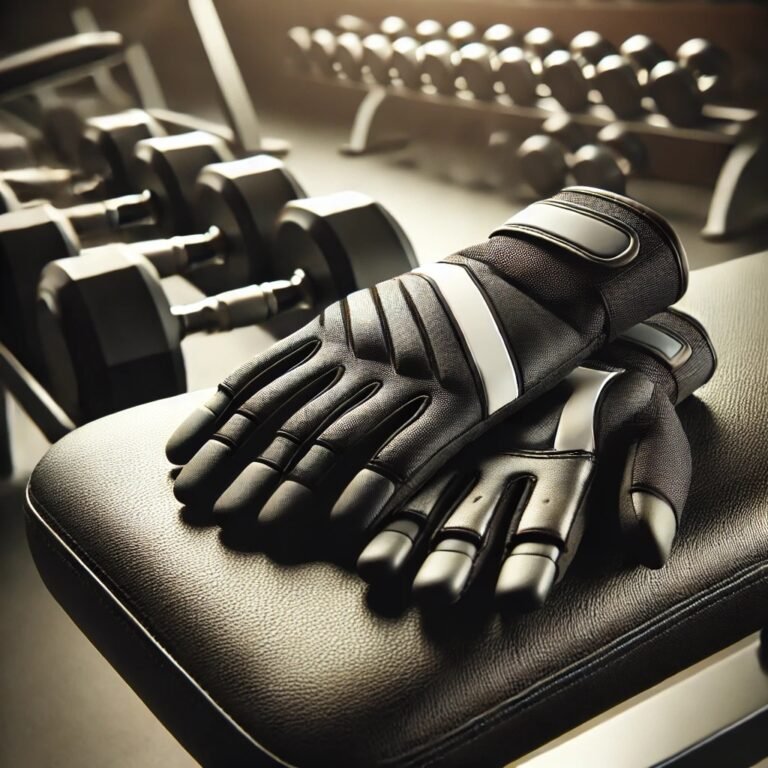
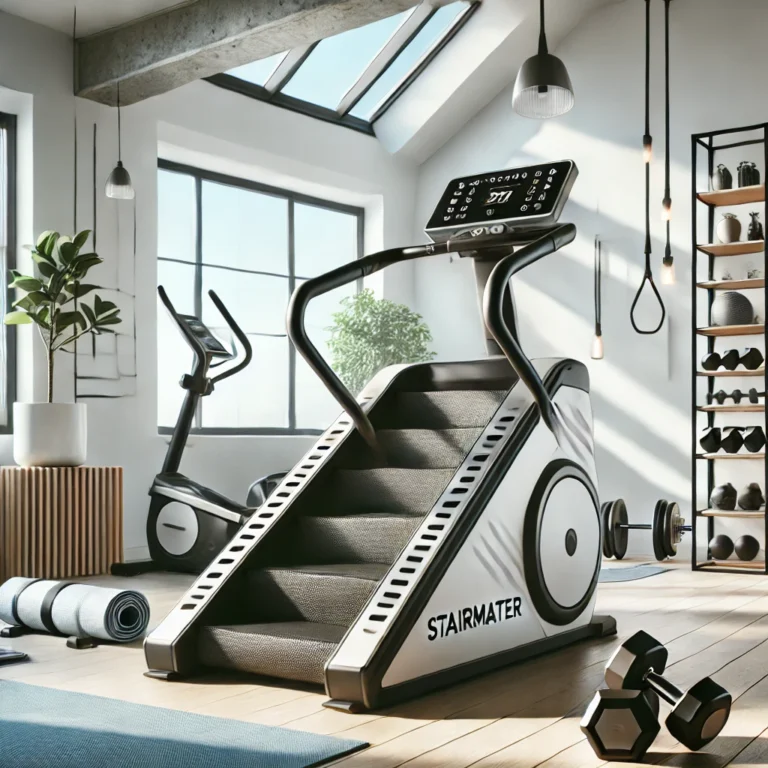

One Comment
Comments are closed.